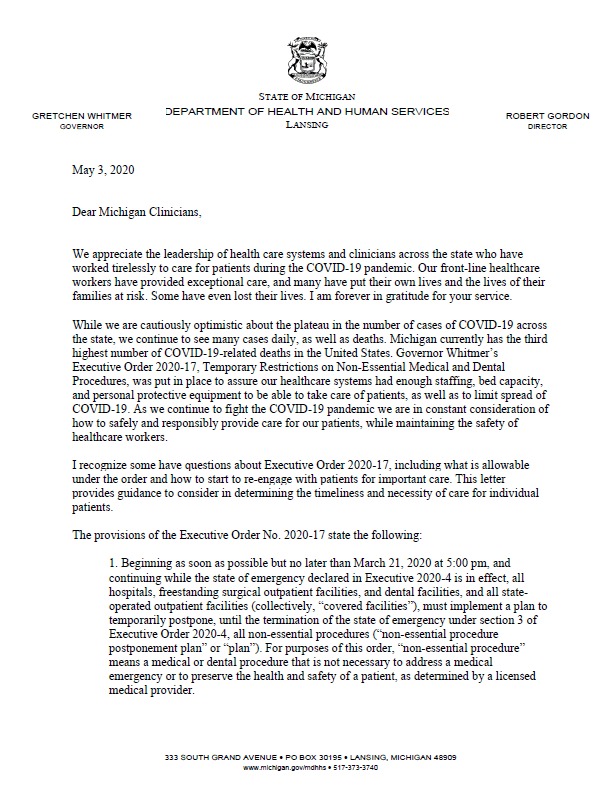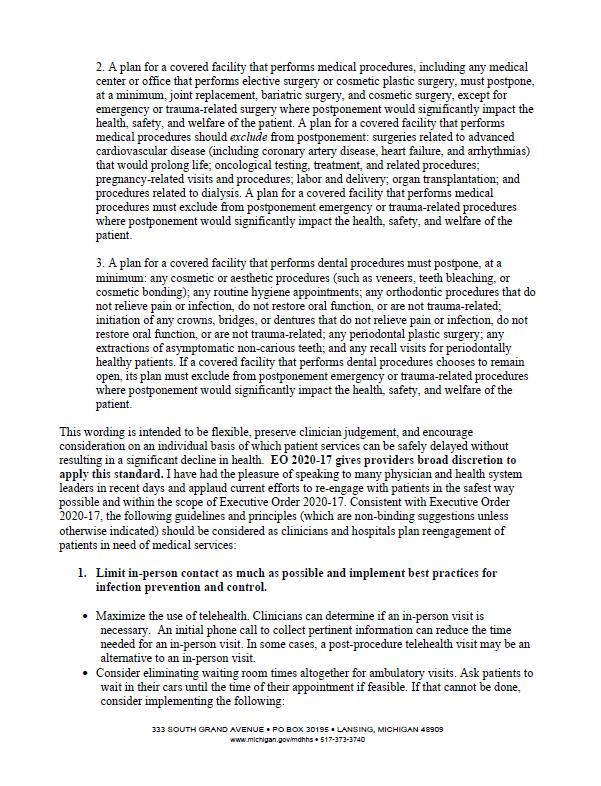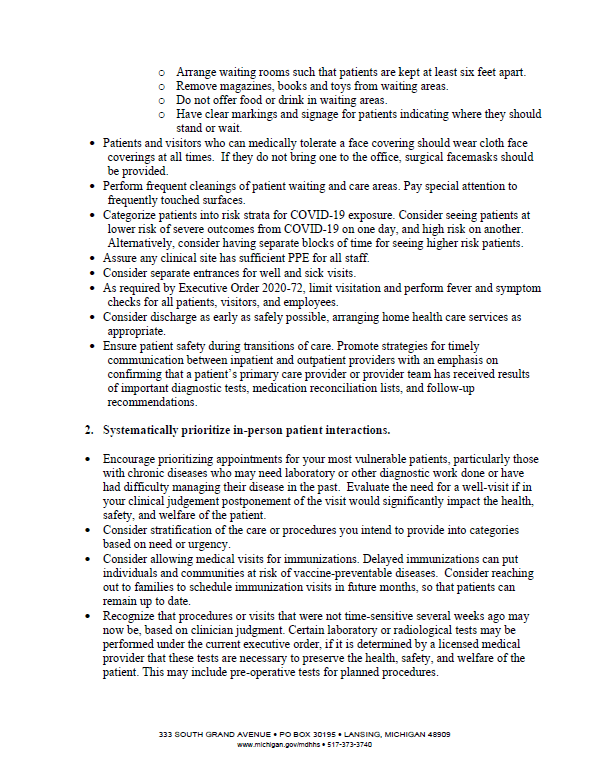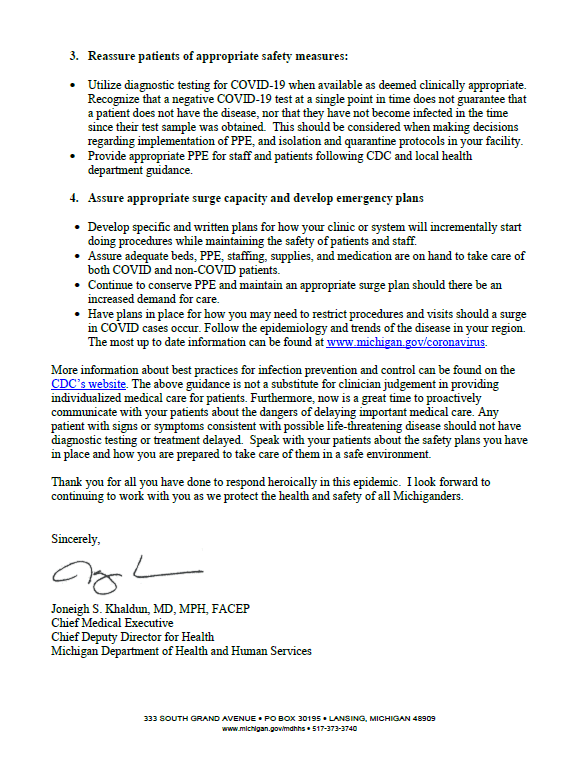Dr. Khaldun Provides Clarifications for Health Care Systems to Reengage with Patients on Important Care
May 6, 2020Executive Order 2020-17 put temporary restrictions on non-essential medical and dental procedures to assure our health care systems had enough staffing, bed capacity and personal protective equipment to be able to take care of patients as the state was trying to limit the spread of COVID-19.
In a recent letter, Dr. Khaldun shared the following provisions:
“This wording is intended to be flexible, preserve clinician judgment, and encourage consideration on an individual basis of which patient services can be safely delayed without resulting in a significant decline in health. EO 2020-17 gives providers broad discretion to apply this standard. I have had the pleasure of speaking to many physician and health system leaders in recent days and applaud current efforts to re-engage with patients in the safest way possible and within the scope of Executive Order 2020-17. Consistent with Executive Order 2020-17, the following guidelines and principles (which are non-binding suggestions unless otherwise indicated) should be considered as clinicians and hospitals plan reengagement of patients in need of medical services:
Limit in-person contact as much as possible and implement best practices for infection prevention and control.
- Maximize the use of telehealth. Clinicians can determine if an in-person visit is necessary. An initial phone call to collect pertinent information can reduce the time needed for an in-person visit. In some cases, a post-procedure telehealth visit may be an alternative to an in-person visit.
- Consider eliminating waiting room times altogether for ambulatory visits. Ask patients to wait in their cars until the time of their appointment if feasible. If that cannot be done, consider implementing the following:
- Arrange waiting rooms such that patients are kept at least six feet apart.
- Remove magazines, books, and toys from waiting areas.
- Do not offer food or drink in waiting areas.
- Have clear markings and signage for patients indicating where they should stand or wait.
- Patients and visitors who can medically tolerate a face covering should wear cloth face coverings at all times. If they do not bring one to the office, surgical facemasks should be provided.
- Perform frequent cleanings of patient waiting and care areas. Pay special attention to frequently touched surfaces.
- Categorize patients into risk strata for COVID-19 exposure. Consider seeing patients at lower risk of severe outcomes from COVID-19 on one day, and high risk on another. Alternatively, consider having separate blocks of time for seeing higher-risk patients.
- Assure any clinical site has sufficient PPE for all staff.
- Consider separate entrances for well and sick visits.
- As required by Executive Order 2020-72, limit visitation and perform fever and symptom checks for all patients, visitors, and employees.
- Consider discharge as early as safely possible, arranging home health care services as appropriate.
- Ensure patient safety during transitions of care. Promote strategies for timely communication between inpatient and outpatient providers with an emphasis on confirming that a patient’s primary care provider or provider team has received results of important diagnostic tests, medication reconciliation lists, and follow-up recommendations.
Systematically prioritize in-person patient interactions.
- Encourage prioritizing appointments for your most vulnerable patients, particularly those with chronic diseases who may need laboratory or other diagnostic work done or have had difficulty managing their disease in the past. Evaluate the need for a well-visit if in your clinical judgment postponement of the visit would significantly impact the health, safety, and welfare of the patient.
- Consider stratification of the care or procedures you intend to provide into categories based on need or urgency.
- Consider allowing medical visits for immunizations. Delayed immunizations can put individuals and communities at risk of vaccine-preventable diseases. Consider reaching out to families to schedule immunization visits in future months, so that patients can remain up to date.
- Recognize that procedures or visits that were not time-sensitive several weeks ago may now be, based on clinician judgment. Certain laboratory or radiological tests may be performed under the current executive order, if it is determined by a licensed medical provider that these tests are necessary to preserve the health, safety, and welfare of the patient. This may include pre-operative tests for planned procedures.
Reassure patients of appropriate safety measures:
- Utilize diagnostic testing for COVID-19 when available as deemed clinically appropriate. Recognize that a negative COVID-19 test at a single point in time does not guarantee that a patient does not have the disease, nor that they have not become infected in the time since their test sample was obtained. This should be considered when making decisions regarding the implementation of PPE, and isolation and quarantine protocols in your facility.
- Provide appropriate PPE for staff and patients following the CDC and local health department guidance.
Assure appropriate surge capacity and develop emergency plans:
- Develop specific and written plans for how your clinic or system will incrementally start doing procedures while maintaining the safety of patients and staff.
- Assure adequate beds, PPE, staffing, supplies, and medication are on hand to take care of both COVID and non-COVID patients.
- Continue to conserve PPE and maintain an appropriate surge plan should there be an increased demand for care.
- Have plans in place for how you may need to restrict procedures and visits should a surge in COVID cases occur. Follow the epidemiology and trends of the disease in your region. The most up to date information can be found at www.michigan.gov/coronavirus.”




